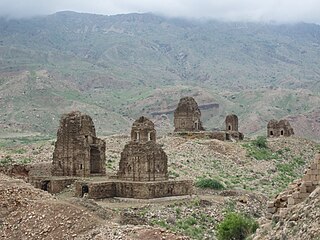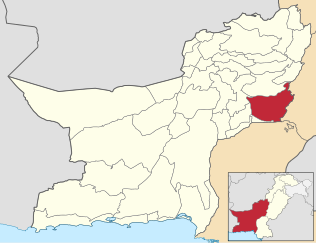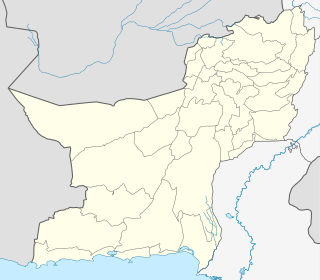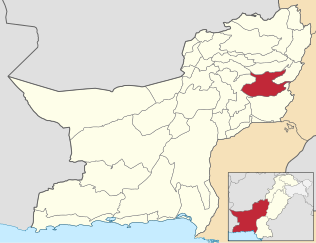
The Baloch are an Iranian people who live mainly in the Balochistan region of the southeasternmost edge of the Iranian plateau in Pakistan, Iran, and Afghanistan. There are also diaspora communities in neighboring regions, including those in India; and having a significant diaspora in the Arabian Peninsula.

Dera Ismail Khan District is a district in Dera Ismail Khan Division of Khyber Pakhtunkhwa province in Pakistan. The capital of the district is the town of Dera Ismail Khan. The district has an area of 9,334 km2 (3,604 sq mi) and a population of 852,995 as of the 1998 Census.
Bugti is a Baloch tribe found in eastern Balochistan, Pakistan. As of 2008, it was estimated to comprise over 180,000 people, mostly living in the Dera Bugti region of Pakistan. They are in turn divided into the Rahija Bugti, Masori Bugti, Mondrani Bugti, Habibani Bugti, Kalpar Bugti and Mareta sub-tribes. Their neighbours to the north are the Marri, who were the Bugti's traditional enemies.

Nawab Akbar Shahbaz Khan Bugti was the Tumandar (head) of the Bugti tribe of Baloch people who served as the Minister of State for Interior and Governor of Balochistan Province in Pakistan. He also became minister of state for defence in the cabinet of Feroz Khan Noon. Earlier, he has also served as the minister of state for interior.

Dera Bugti is a district within the Balochistan province of Pakistan. It was established as a separate district in 1983.

Barkhan (Urdu: بارکھان, pronunciation is a district in the Pakistani province of Balochistan. It shares its borders with the province of Punjab to the east and the Balochistan districts of Dera Bugti to the south, Kohlu to the west, Loralai to the northwest and Musakhel to the north. The district's headquarters is the town of Barkhan. It was granted the status of a separate district on 31 December 1991, prior to which it was a tehsil within Loralai District.

Jafarabad district lies in southeast of the Pakistani province of Balochistan. Jafarabad's headquarters are at Dera Allah Yar formerly and still known as Jhatpat among locals. Jaffarabad District is sub-divided into three tehsils. The main tribes of this district are: Soomro, Jamali, Khoso,Bulledi, Magsi, Babbar, Mengal, Sumalani, Badini, Rakhshani, Pandatani, Jattak, Behrani while internally displaced people of Marri, Bugti tribes also live in Jafarabad. Other minority communities are Gola, Umrani, Lashari, Domki, Kanrani, Gajani, Siapad Brohi and small number of Bhanger, Abro tribes.

Kohlu is a district of the Balochistan province of Pakistan. It is bounded in the north by Loralai District, Dera Bugti in the south, Barkhan in the east, and Sibi District in the west. According to the 1998 census of Pakistan it had a population of 99,850. The most widely spoken first languages are Balochi (91%) and Pashto (6.6%).

Sibi is a district in the Balochistan province of Pakistan. The main mountain ranges are Zen, Bambore and Dungan. The climatic and topography of Sibi District is quite varied compared to other districts of Balochistan. It is also known as the "Hot spot" of Pakistan where the temperatures in the summer exceed 52.6 °C (126.7 °F). Until 2013 the district had two sub-divisions, Sibi and Lehri, further organized into tehsils and sub-tehsils: Sibi, Lehri, Kutmandi and Sangan.
The Marri are a Balochi-speaking tribe of the Baloch people, who inhabit a large arid region in northeastern Balochistan, Pakistan. The Marri area is bounded to the west by the plains of Sibi, to the north are the Kakar and Loni tribes of the Pashtuns, to the east lie the lands of the Khetrans - speakers of an Indo-Aryan language Khetrani, while to the south are found the Marri's traditional enemies, the Bugti Baloch.

The Khetran are a Baloch tribe found primarily in the northeast of the Balochistan province of Pakistan. Their area is a large hilly tract in the Sulaiman Mountains comprising the whole of Barkhan District as well as small parts of neighbouring Kohlu District to the south-west, and Musakhel District to the north. The total population is about 150,000, and at least two-thirds are speakers of the Khetrani language. The Khetrans settled to the east in the Dera Ghazi Khan District of Punjab are speakers of Saraiki.
Sui, is a sub-district of Dera Bugti District in Balochistan, Pakistan. The Sui gas field is located near Sui town. Generally this is the area of Bugti's.
Mawand is located in the Kohlu District of Balochistan, Pakistan. With a population of approximately 5000 people, it is located in district Kohlu and previously it was NCB division It is the place where the first helicopter to start the counter-insurgency operations landed. A fort housing the Frontier Corpsmen and officers also existed there but was destroyed in an earthquake.
Marri-Bugti Country was a tribal region during the British occupation of Baluchistan. Marris and Bugtis are the strongest Baloch tribes in the Balochistan. The Marris occupied 8,460 square kilometres (3,268 sq mi) in the north, while the Bugtis occupied 10,000 square kilometres (3,861 sq mi) in the south. Today, the region is divided into three districts: Kohlu, Dera Bugti and Sibi.
Khetrānī, or Khetranki, is an Indo-Aryan language of north-eastern Balochistan. It is spoken by the majority of the Khetrans, a Baloch tribe that occupies a hilly tract in the Sulaiman Mountains comprising the whole of Barkhan District as well as small parts of neighbouring Kohlu District to the south-west, and Musakhel District to the north. The ethnic Khetran population found to the east in the Dera Ghazi Khan District of Punjab instead speak Saraiki. Alternative names for the language attested at the start of the 20th century are Barāzai and Jāfaraki.

Ramin or Rāman is a town and union council of Dera Ghazi Khan District in the Punjab province of Pakistan.
The Anglo-Marri Wars is the name given to three major military conflicts between the Marri Baluch tribesmen and the British Empire in the independent eastern Baloch tribal belt. The conflicts took place in the 19th and 20th centuries, specifically in 1840, 1880 and 1917.

Rukhala is a village under Giddarbaha Tehsil in Sri Muktsar Sahib district in the Indian state of Punjab.

Daajal is a small town in the south-west of Punjab, Pakistan. It is located in Jampur Tehsil, Rajanpur District. It has a population of around 50,000, and the main languages spoken are Saraiki and Balochi.













